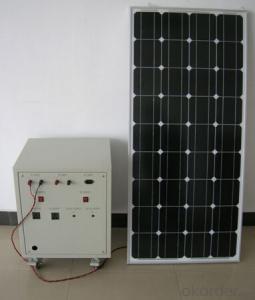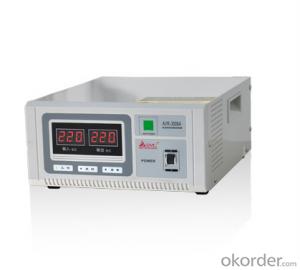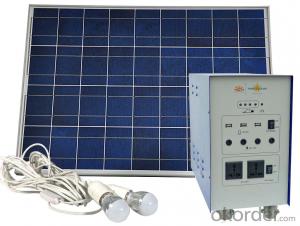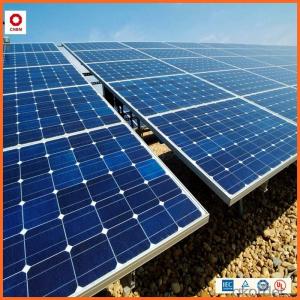CNBM Solar Home System Roof System Easy installation Capacity-300W
- Loading Port:
- Shanghai
- Payment Terms:
- TT or LC
- Min Order Qty:
- 100 PCS
- Supply Capability:
- 500000 PCS/month
OKorder Service Pledge
OKorder Financial Service
You Might Also Like
Introduction of Solar Energy
In the last two decades, photovoltaics (PV), also known as solar PV, has evolved from a pure niche market of small scale applications towards becoming a mainstream electricity source. A solar cell is a device that converts light directly into electricity using the photoelectric effect. The first solar cell was constructed by Charles Fritts in the 1880s. In 1931 a German engineer, Dr Bruno Lange, developed a photo cell using silver selenide in place of copper oxide. Although the prototype selenium cells converted less than 1% of incident light into electricity, both Ernst Werner von Siemens and James Clerk Maxwell recognized the importance of this discovery. Following the work of Russell Ohl in the 1940s, researchers Gerald Pearson, Calvin Fuller and Daryl Chapin created the crystalline silicon solar cell in 1954. These early solar cells cost 286 USD/Watt and reached efficiencies of 4.5–6%. By 2012 available efficiencies exceed 20% and the maximum efficiency of research photovoltaics is over 40%.
Introduction of Solar Home System
Solar Home System is composed by Solar Panels, Inverters, Charger Controller, Battery, Cable, Mounting Bracket, which is applied to produce electricity for home use.
Solar Home System is quite suitable product in urban area and the place which is short of electricity. As the cost of solar products reduced, more and more family can bear the charge of solar products. These products apply to schools, hospitals, public halls and private housing, communication stations, weather station. Also can use as household appliances, lighting, communications equipment, meteorological equipment.
Our company’s main target is to make every family can use cheap solar energy and enjoy the new innovation of modern science and technology.
Picture of Our Factory

Working Principle of Solar Home System
This is an off-grid solar system which uses batteries to store the solar energy, at the same time, the solar system can be connected with the grid for utilization of grid power. The solar system uses battery power in priority, but when sunshine is not so good or loads consumption is too big which caused the battery power inadequacy, then the system can switch automatically to grid power supply. Meanwhile, the system can charge the batteries with grid power until batteries are fully charged. Then the solar system will switch back to battery power supply.
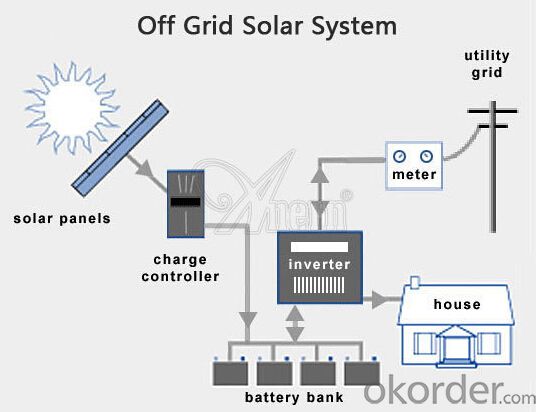
Product Details of Solar Home System
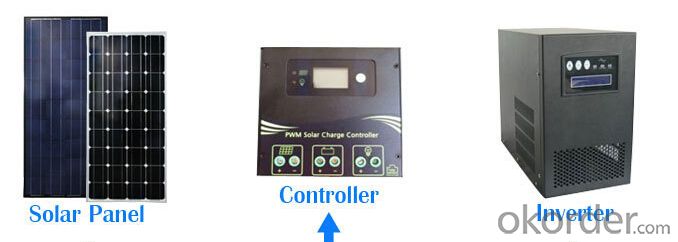


Specification of Solar Home System
Technical data: | |||||||||
Inverter | Rated load power | 1000W | |||||||
Output wave | Pure sine wave | ||||||||
Input voltage | 24V | ||||||||
Output voltage | DC:12V | ||||||||
Output frequency | 50HZ/60HZ | ||||||||
Precision of output frequency | ±6% | ||||||||
Solar panel | Pmax | 150W*2PCS | |||||||
Vmp | 36V | ||||||||
Imp | 8.34A | ||||||||
Charger | Charger voltage & current | 24V/20A | |||||||
Battery | Capacity | 12V100AH*2PCS | |||||||
Power box | Spray paint iron box,with input,output, ammeter,voltmeter,master switch and so on. | ||||||||
Package data: | |||||||||
Part | Size (L*W*H mm) | Weight (kg) | 20' (pcs) | 40' (pcs) | |||||
Power box | 580*520*540 | 60 | 84Sets | 200Sets | |||||
Solar panel | 1500*700*90 | 24 | |||||||
Solar panel bracket |
|
| |||||||
Loading electrical equipment(For consult) | |||||||||
Name of Load | Power(W) | Quantity | Working Time per Day (H) | Working Days | |||||
Color TV | 65W | 1 | 6 | 3 days | |||||
Satellite TV Receivers | 25W | 1 | 6 | 3 days | |||||
lamp | 11W | 2 | 8 | 3 days | |||||
Other | 150W |
| 2 | 3 days | |||||
Advantage of Our Solar Home System
1 Excellent Performance: Our Solar Home System is composed by Brand Standard Kits with high quality. Our solar system has the advantage of high efficiency and stable operation. We can ensure our product with a long life period.
2. Small Orders Accepted: We can accept small orders as our customer’s trial order.
3. Guarantee/Warranty: We supply 10 Years Product Warranty and 25 Years Performance warranty.
4. Warehouse: We have warehouse overseas which can bring great convenience to our customer to pick up the products.
FAQ
Q: You are a manufacturer or Trader?
A: We are a Group corp. with 1GW capacity, which is Okorder’s registered VIP Supplier, enjoy Okorder’s Financial Guarantee.
Q: Required mainly certificates (CE&IEC/TUV/RoHS)?
A: Our products are certificated by CE RoHS, IEC, C-tick etc.
Q: Your main exported market is?
A: Main markets of our products is: South-east Asia, Mid-east, Arica, East Europe and Latin America.
- Q:What is the impact of hurricanes on solar panels?
- Hurricanes can have a significant impact on solar panels. The high winds associated with hurricanes can potentially damage or dislodge solar panels from their mountings, especially if they are not properly secured. This can result in the complete destruction of the panels or render them ineffective in generating electricity. Additionally, flying debris during a hurricane can cause physical damage to the solar panels, such as cracks or shattered glass. This damage can impair the functionality of the panels and decrease their efficiency in converting sunlight into electricity. The heavy rainfall that often accompanies hurricanes can also pose a threat to solar panels. If water seeps into the panels, it can cause electrical short circuits or damage to the internal components, rendering them unusable. Furthermore, hurricanes can cause power outages, which can affect the functionality of solar panels. If the electric grid is down, the solar panels may not be able to send excess energy back into the grid or receive power from it, limiting their ability to generate electricity. However, it is worth noting that solar panels are designed to withstand various weather conditions, including strong winds and heavy rain. Properly installed and maintained solar panels can have a higher likelihood of surviving a hurricane with minimal damage. Additionally, advancements in solar panel technology, such as stronger glass and improved mounting systems, are continuously being made to enhance their resilience to extreme weather events. Overall, while hurricanes can have a negative impact on solar panels, with proper precautions and maintenance, their durability can be improved, making them a viable and sustainable energy option even in hurricane-prone areas.
- Q:What is the role of solar batteries in storing excess solar energy?
- The role of solar batteries in storing excess solar energy is to capture and store the surplus energy produced by solar panels during periods of high production, such as sunny days. These batteries store the excess energy for later use, allowing households and businesses to have a reliable source of electricity during times when solar production is low or non-existent, such as at night or during cloudy days. By storing the excess energy, solar batteries help increase energy self-sufficiency, reduce reliance on the grid, and promote renewable energy utilization.
- Q:Can solar energy systems be easily expanded or upgraded?
- Yes, solar energy systems can be easily expanded or upgraded. One of the major advantages of solar technology is its modular nature, allowing for scalability and flexibility. If you have additional space available, you can simply add more solar panels to increase the capacity of your system. Additionally, advancements in solar technology have made it easier to integrate new panels with existing systems. Upgrading a solar energy system can also be done by replacing older or less efficient components with newer and more efficient ones, such as upgrading to higher capacity inverters or adding battery storage for energy storage purposes. The expandability and upgradability of solar energy systems make them a cost-effective and sustainable choice for meeting increasing energy demands over time.
- Q:Can solar energy systems be used in areas with limited access to solar energy financing options?
- Yes, solar energy systems can be used in areas with limited access to solar energy financing options. In such cases, alternative financing models like community solar or power purchase agreements (PPAs) can be utilized. Additionally, organizations and governments can offer subsidies or incentives to make solar energy systems more affordable and accessible in these areas.
- Q:Are there any government incentives or tax credits for installing a solar energy system?
- Yes, there are several government incentives and tax credits available for installing a solar energy system. These incentives and credits aim to promote the use of renewable energy sources and reduce dependence on fossil fuels. One of the most significant incentives is the federal Investment Tax Credit (ITC) which allows homeowners and businesses to deduct a portion of the cost of installing a solar energy system from their federal taxes. As of 2021, the ITC offers a 26% tax credit for residential and commercial solar installations. However, it is important to note that the percentage may change in the following years, so it is advisable to take advantage of the current rate. Additionally, some states and local governments offer their own incentives and tax credits for solar installations. These incentives can vary widely, but they often include rebates, grants, or property tax exemptions for homeowners and businesses that adopt solar energy systems. Furthermore, there are also net metering programs in many states that allow solar system owners to receive credits on their utility bills for any excess electricity they generate and feed back into the grid. This allows solar energy system owners to offset their electricity costs and potentially earn money by selling surplus energy. In conclusion, there are numerous government incentives and tax credits available for installing a solar energy system. These incentives aim to make solar installations more affordable and encourage the transition to clean, renewable energy sources. It is advisable to consult with local authorities, utility companies, and tax professionals to fully understand and take advantage of the incentives and credits available in your area.
- Q:Can solar energy systems be used for emergency response operations?
- Yes, solar energy systems can be used for emergency response operations. Solar power can provide a reliable source of electricity during emergencies, ensuring critical operations such as communication, lighting, medical equipment, and water pumping are sustained. These systems are portable, easy to deploy, and do not rely on an external power grid, making them suitable for remote or disaster-stricken areas. Additionally, solar energy is a clean and renewable resource, reducing reliance on fossil fuels and minimizing environmental impact during emergency operations.
- Q:Can solar energy systems be used in areas with limited grid infrastructure?
- Yes, solar energy systems can definitely be used in areas with limited grid infrastructure. In fact, one of the greatest advantages of solar energy is its ability to provide electricity in remote and off-grid locations. Solar panels generate electricity by converting sunlight into energy, which means they do not rely on a connection to the traditional power grid. This makes solar energy systems an ideal solution for remote areas, such as rural communities or developing regions, where extending the grid infrastructure may not be financially viable or technically feasible. By installing solar panels and using energy storage systems, such as batteries, these areas can generate and store their own electricity, even during periods of low sunlight or at night. This not only provides access to reliable and clean energy but also promotes energy independence and resilience in areas with limited grid infrastructure. Additionally, solar energy systems can be easily scaled up or down based on the energy needs of the community, making them a flexible and sustainable solution for powering areas with limited grid infrastructure.
- Q:What is the role of solar energy systems in promoting sustainability?
- Solar energy systems play a crucial role in promoting sustainability by providing a clean, renewable, and abundant source of energy. Unlike fossil fuels, which emit harmful greenhouse gases and contribute to climate change, solar energy systems generate power without producing any pollution or emissions. This not only helps to mitigate the negative impacts of climate change but also reduces the dependence on finite fossil fuel resources, which are rapidly depleting. Solar energy systems also contribute to sustainability by decentralizing energy production. Traditional energy sources, such as coal-fired power plants, are typically large-scale and located far away from the end-users. This results in significant energy losses during transmission and distribution. In contrast, solar energy systems can be installed on rooftops or in close proximity to where the energy is needed, reducing energy losses and improving overall efficiency. Additionally, solar energy systems enable individuals and communities to become more self-sufficient and less reliant on centralized energy grids. By producing their own electricity, households and businesses can reduce their energy bills and have a more stable and reliable energy supply, especially in remote areas or during power outages. This decentralization also helps to enhance energy security and resilience, as it reduces the vulnerability to disruptions caused by natural disasters, cyber-attacks, or other emergencies. Furthermore, solar energy systems have a long lifespan and require minimal maintenance, resulting in lower operational costs compared to conventional power generation technologies. This makes solar power an economically viable option, particularly over the long term. As the cost of solar panels and related technologies continues to decline, more individuals, businesses, and governments are investing in solar energy systems, driving further adoption and creating a positive feedback loop for sustainability. The role of solar energy systems in promoting sustainability extends beyond the environmental and economic benefits. Solar power can also have social implications by providing access to electricity for communities that are currently underserved or lack reliable energy sources. This can improve the quality of life, support economic development, and enable educational opportunities, especially in developing countries. In summary, solar energy systems play an integral role in promoting sustainability by reducing greenhouse gas emissions, improving energy efficiency, enhancing energy security, and fostering economic development. By harnessing the power of the sun, we can create a more sustainable future for generations to come.
- Q:Is it possible to store excess solar energy for later use?
- Yes, it is possible to store excess solar energy for later use. This can be done through various methods such as using batteries, pumped hydro storage, or converting the energy into hydrogen or other forms of fuel for later use.
- Q:Can solar energy systems be used for powering refrigeration systems?
- Solar energy systems have the capability to power refrigeration systems. Through the use of solar panels, solar energy can be converted into electricity, which can then be utilized to operate refrigeration systems. This is commonly achieved by employing photovoltaic (PV) systems, which convert sunlight into electricity using semiconducting materials. The electricity generated by these systems can be employed to power the compressors and other components of refrigeration systems, enabling them to function independently from traditional power sources. By harnessing solar energy for refrigeration, not only can energy costs be reduced, but also the environmental impact can be minimized, as solar energy is a clean and renewable power source.
1. Manufacturer Overview |
|
|---|---|
| Location | |
| Year Established | |
| Annual Output Value | |
| Main Markets | |
| Company Certifications | |
2. Manufacturer Certificates |
|
|---|---|
| a) Certification Name | |
| Range | |
| Reference | |
| Validity Period | |
3. Manufacturer Capability |
|
|---|---|
| a)Trade Capacity | |
| Nearest Port | |
| Export Percentage | |
| No.of Employees in Trade Department | |
| Language Spoken: | |
| b)Factory Information | |
| Factory Size: | |
| No. of Production Lines | |
| Contract Manufacturing | |
| Product Price Range | |
Send your message to us
CNBM Solar Home System Roof System Easy installation Capacity-300W
- Loading Port:
- Shanghai
- Payment Terms:
- TT or LC
- Min Order Qty:
- 100 PCS
- Supply Capability:
- 500000 PCS/month
OKorder Service Pledge
OKorder Financial Service
Similar products
New products
Hot products
Hot Searches
Related keywords
